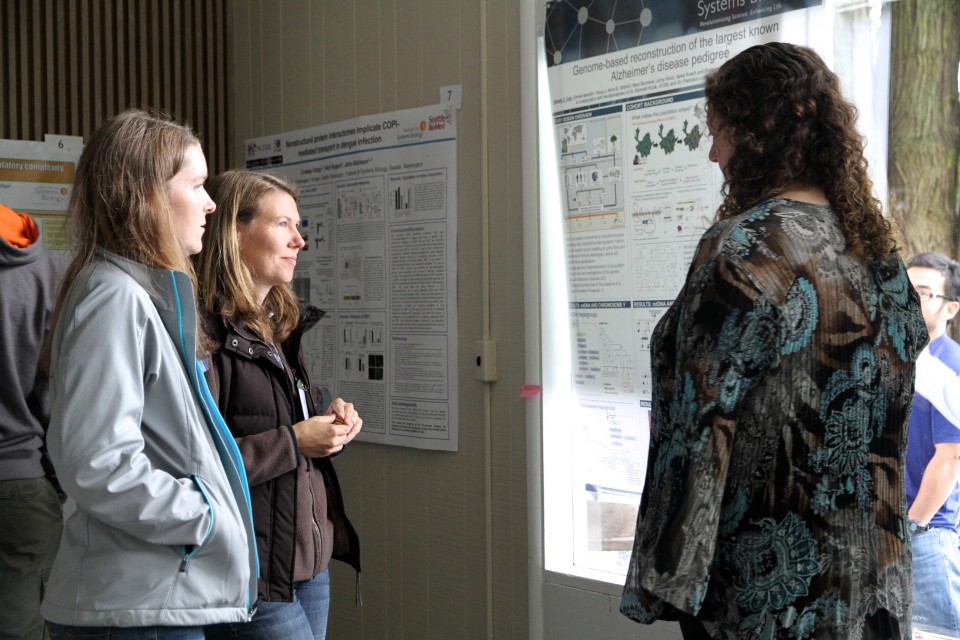ISB Retreat 2013: Wellness and Community
 isbscience.org/news/2013/09/26/isb-retreat-2013-wellness-and-community/
isbscience.org/news/2013/09/26/isb-retreat-2013-wellness-and-community/
“This is the best retreat we’ve ever had – I say that every year. But this was a singular retreat in that it catalyzed an enormously interesting conversation about future opportunities.” – Lee Hood

During ISB’s annual all-staff retreat, our researchers can share their research progress at one of two poster sessions.
Every September, ISB holds an all-staff overnight retreat to step away from the day-to-day, celebrate the highlights from the past year, ponder the future and, of course, have some fun. We returned to Seabeck Conference Center on Sept. 15-16 for our 2013 retreat.

Senior software engineer Bill Longabaugh flashes a silly smile during a poster session at ISB’s 2013 retreat.
ISB has a long tradition of holding dedicated retreats throughout the year for all staff, individual lab groups, all faculty, senior leadership, and post docs. This time away is important to allow the mental space to reflect, connect with colleagues, inspire new questions and collaborations, and build camaraderie over some fun. As senior software engineer Bill Longabaugh, who recalls some of his questionable karaoke singing from years past, said, “There’s nothing like shared loony, embarrassing behavior to form strong bonds with colleagues, right?”
Nathan Price, ISB’s associate director, and senior research scientist Gustavo Glusman organized the scientific program around the theme “P4 Medicine and Wellness.” Presentations included a keynote from Dr. Szilard Voros, founder and CEO of Global Genomics Group and a practicing cardiologist; lightning talks from ISB researchers on current work; systems biology education; and perspectives on some pending large-scale projects.
“I’ve attended every yearly ISB retreat since 2001,” Gustavo said. “Without exception, these events have brought about improved communication with ISBers – both those I regularly interact with, and those I know only by face and name.”
Gustavo emphasized that retreats have at least five goals: show and tell; listen and discuss; brainstorm and plan; inspire; and have fun.
“Social bonding is crucial,” he said.
For first-timer Julie Thatcher, a new grants and contracts manager at ISB, the retreat was a great opportunity to see a large group of staff in one place and also to begin to get a sense of the diverse work of our researchers.
“It was wonderful to see that ISBers actually live what they talk about regarding wellness,” Julie said. “Also, it was inspiring to know that ISB leaders are striving forward with visionary research while bringing so many mentees along.”
Senior research scientist Vesteinn Thorsson echoes the sentiment about the retreat serving as an ideal venue to learn about work from colleagues. “Meeting people outside of your own immediate work circle is a bonus, especially for those of us who are introverts and wouldn’t do this if left to our devices,” Vesteinn said.

Vesteinn Thorsson was among the group of ISB veterans who were honored for 10 or more years of service.
A new addition to this year’s program was the honoring of staffers who have been with ISB for 10 years or more. There were 40 names on the list, which, considering ISB has been around for only 13 years and has about 230 staff members, is a considerable number. Each person received a specially designed card that was signed by Lee Hood, a lapel pin, and a gift card.
Regarding the high number of veterans on staff, Vesteinn commented: “I think it says the ISB has a commitment to keeping people who are doing valuable work, while at the same time bringing in new folks.”
The main discussion centered around the 100K project that Lee Hood announced in ISB’s 2012 annual report, which was published in July 2013:
I would like to propose that ISB catalyze a longitudinal study of 100,000 “well” individuals over 25 years, creating for each a virtual cloud of billions of data points that include (1) their genome sequences to identify actionable gene variants for which suggestions can be made for improving health; (2) longitudinal blood measurements two to three times a year for analysis with traditional clinical chemistries and assays that employ systems strategies (see below); and (3) high-frequency digital measurements coming from “quantified self” assessments that track exercise, sleep, stress, weight and nutrition. – Lee Hood
“ISB’s culture is all about working together on large, ambitious joint projects,” Lee said. “This year’s retreat was about just that kind of project.”
Visit the photo gallery from the 2013 ISB retreat.







